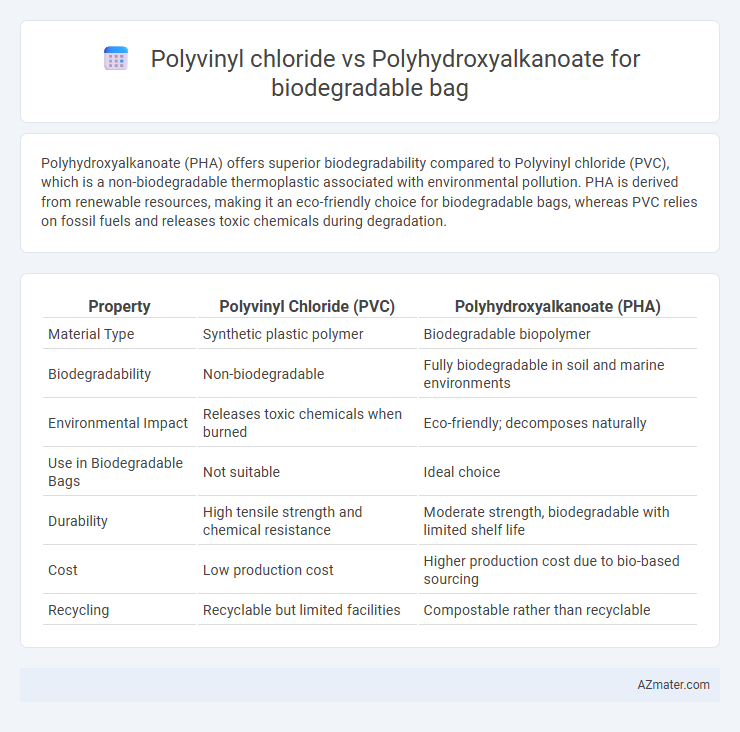Polyhydroxyalkanoate (PHA) offers superior biodegradability compared to Polyvinyl chloride (PVC), which is a non-biodegradable thermoplastic associated with environmental pollution. PHA is derived from renewable resources, making it an eco-friendly choice for biodegradable bags, whereas PVC relies on fossil fuels and releases toxic chemicals during degradation.
Table of Comparison
| Property | Polyvinyl Chloride (PVC) | Polyhydroxyalkanoate (PHA) |
|---|---|---|
| Material Type | Synthetic plastic polymer | Biodegradable biopolymer |
| Biodegradability | Non-biodegradable | Fully biodegradable in soil and marine environments |
| Environmental Impact | Releases toxic chemicals when burned | Eco-friendly; decomposes naturally |
| Use in Biodegradable Bags | Not suitable | Ideal choice |
| Durability | High tensile strength and chemical resistance | Moderate strength, biodegradable with limited shelf life |
| Cost | Low production cost | Higher production cost due to bio-based sourcing |
| Recycling | Recyclable but limited facilities | Compostable rather than recyclable |
Introduction to Biodegradable Bags
Biodegradable bags are developed to reduce environmental pollution by decomposing naturally through microbial activity. Polyhydroxyalkanoate (PHA), a biopolymer produced by bacterial fermentation, offers excellent biodegradability and compostability compared to Polyvinyl chloride (PVC), which is a synthetic plastic with limited degradation potential and persistence in ecosystems. The contrasting properties of PHA and PVC significantly influence their environmental impact and suitability for sustainable packaging solutions.
Overview of Polyvinyl Chloride (PVC)
Polyvinyl Chloride (PVC) is a widely used synthetic plastic polymer known for its durability, chemical resistance, and low cost, making it a common choice in traditional bag manufacturing. However, PVC is not biodegradable and poses significant environmental challenges due to its persistence and the release of harmful chemicals during degradation. In contrast, biodegradable alternatives such as Polyhydroxyalkanoate (PHA) offer environmentally friendly solutions by breaking down naturally, reducing plastic pollution significantly.
Overview of Polyhydroxyalkanoate (PHA)
Polyhydroxyalkanoate (PHA) is a biodegradable polymer produced by microbial fermentation of renewable resources, offering a sustainable alternative to conventional plastics like polyvinyl chloride (PVC). PHAs exhibit excellent biodegradability, compostability, and low toxicity, making them ideal for eco-friendly bag production. Their physical properties, such as flexibility and water resistance, can be tailored through microbial strains and processing methods, enhancing their suitability for diverse packaging applications.
Environmental Impact: PVC vs. PHA
Polyvinyl chloride (PVC) bags release toxic chemicals such as dioxins and phthalates during production and degradation, posing significant environmental hazards and persistence in landfills for hundreds of years. In contrast, polyhydroxyalkanoate (PHA) bags are biodegradable, breaking down into non-toxic substances through microbial activity within months, significantly reducing pollution and greenhouse gas emissions. The lifecycle assessment of PHA demonstrates a lower carbon footprint and minimal ecological harm compared to the high environmental cost associated with PVC production and disposal.
Biodegradability Comparison: PVC vs. PHA
Polyhydroxyalkanoate (PHA) exhibits superior biodegradability compared to Polyvinyl chloride (PVC), breaking down efficiently in natural environments such as soil and marine settings within months. PVC, a petroleum-based polymer, resists biodegradation, persisting for decades and contributing to long-term environmental pollution due to its chlorine content and chemical stability. The biodegradation of PHA involves microbial enzymatic activity producing water and carbon dioxide, making it an environmentally sustainable option for biodegradable bags over conventional PVC alternatives.
Mechanical Properties and Durability Analysis
Polyvinyl chloride (PVC) exhibits high tensile strength and excellent durability but has poor biodegradability, making it less suitable for eco-friendly bag applications. Polyhydroxyalkanoate (PHA) offers moderate mechanical strength with enhanced biodegradability and good flexibility, allowing it to degrade naturally without compromising functional performance. Comparative studies highlight PHA's balanced mechanical properties and environmental benefits, while PVC remains favored for long-term durability in non-biodegradable contexts.
Manufacturing Process and Cost Efficiency
Polyvinyl chloride (PVC) manufacturing involves polymerization of vinyl chloride monomers through processes like suspension or emulsion polymerization, resulting in low production costs but poor biodegradability. Polyhydroxyalkanoate (PHA) synthesis relies on bacterial fermentation of renewable resources, which is more complex and expensive but yields fully biodegradable polymers suitable for eco-friendly bags. Cost efficiency favors PVC due to established large-scale production, while PHA's higher manufacturing costs are offset by its environmental benefits in sustainable packaging.
Safety and Health Considerations
Polyvinyl chloride (PVC) poses significant safety risks due to the release of harmful chemicals like dioxins and phthalates during production and disposal, which can adversely affect human health and the environment. In contrast, polyhydroxyalkanoates (PHAs) are biodegradable biopolymers derived from renewable resources, exhibiting low toxicity and safer degradation byproducts that reduce health hazards. PHAs' biocompatibility and non-toxic nature make them a preferable choice over PVC for environmentally friendly and health-conscious biodegradable bag applications.
Practical Applications in Consumer Packaging
Polyvinyl chloride (PVC) is widely used in consumer packaging due to its durability, chemical resistance, and cost-effectiveness, but it lacks biodegradability, raising environmental concerns. Polyhydroxyalkanoate (PHA) offers a fully biodegradable alternative, derived from microbial fermentation, making it ideal for eco-friendly bags that minimize plastic pollution in consumer packaging. PHAs are increasingly adopted in biodegradable bags where compostability and reduced carbon footprint are critical, while PVC remains prevalent in non-biodegradable applications requiring high performance and longevity.
Future Prospects and Industry Trends
Polyhydroxyalkanoate (PHA) offers significant future prospects over Polyvinyl chloride (PVC) in biodegradable bag applications due to its 100% biocompatibility and complete biodegradability within months under natural conditions. Industry trends emphasize increasing adoption of PHA driven by regulatory pressure to reduce plastic pollution and consumer demand for sustainable packaging materials. Technological advancements are improving PHA production scalability and cost-efficiency, positioning it as a viable alternative to PVC in the global biodegradable plastics market.

Infographic: Polyvinyl chloride vs Polyhydroxyalkanoate for Biodegradable Bag
 azmater.com
azmater.com